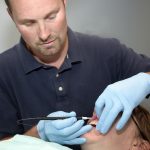
TMJ & SLEEP THERAPY CENTRE OF
RALEIGH-DURHAM
For more information, contact:
Charles Ferzli, DDS, FAACP, DABCP, DABCDSM, DABDSM
TMJ & SLEEP THERAPY CENTRE OF RALEIGH-DURHAM
1150 NW Maynard Road, Suite 140
Cary, NC 27513
Telephone: (919) 323-4242
RaleighTMJandSleep@gmail.com
https://RaleighTMJandSleep.com
For most of Dr. Charles Ferzli’s patients, their healing journey is rarely a straight path. Dr. Ferzli is the founder of the TMJ & Sleep Therapy Centre in Cary. And, as the name of his practice suggests, there is a complex relationship between sleep issues and jaw and facial pain—making diagnosis and treatment challenging.
“It can sometimes be hard to describe the work I do,” acknowledges Dr. Ferzli. “Patients come here seeking relief from jaw pain, or headaches, or sleep issues—and many other symptoms. Often, they arrive here after having seen many other specialists and without having found a solution— or even an explanation—for their problems.
“That’s because their symptoms come from a complex interplay of problems,” he says. “The original source—or sources—may be elusive and can trigger an increasing cascade of problems. Jaw pain, whatever its cause, may contribute to breathing issues, which in turn, result in sleep problems; poor sleep interferes with healing. Inflammation, structural issues, allergies, or poor diet also contribute to sleep problems, again interfering with healing. And so on. The solution is to understand how these factors work together, and—in effect—to ‘rewind’ or ‘retrace’ the path you’re on.”
One Patient’s Journey
Perhaps the best way to explain this process, says Dr. Ferzli, is by recounting the journey of a recent patient.
“Beth is fairly typical of many of my patients. She came to me indirectly—because I was treating her son’s TMJD (Temporomandibular Joint Disorder). In learning about her son’s treatment, she realized that she, too, had TMJ problems.”
In fact, Beth’s problems had persisted for years, and her pursuit of relief led her down multiple paths, says Dr. Ferzli. “Neck pain and pressure in her jaw led her to get braces and other dental work—but her symptoms continued. About a year and a half before coming to work with me, she was diagnosed with severe obstructive sleep apnea, and although she now uses a CPAP, which helps her sleep, no one made the connection between her sleep apnea and her neck pain. As a consequence, she did not realize that she was also dealing with significant TMJ issues.
“As with all new patients,” explains Dr. Ferzli, “we began Beth’s treatment with extensive testing to determine the source of the problem. And because so many factors may contribute to jaw and sleep issues, our evaluation process is extensive.
“It starts with a clinical evaluation, palpating the jaw and surrounding muscles. We then use a variety of instruments—including a jaw tracker, X-rays, and jaw joint vibration analysis—to assess the health of the jaw joint and evaluate range of motion in the head, neck, and jaw.
“Beth’s scans revealed that her jaw was out of alignment and had started to deform in its shape. These issues, possibly genetic, not only contributed to the pain in her neck and jaw, but affected her airway passages. That certainly contributed to her sleep apnea.”
Many Contributing Factors
“In many ways,” observes Dr. Ferzli, “Beth’s case is a perfect illustration of the complexity of TMJ and sleep issues; and her healing path reflects that complexity.
“Neck and jaw pain led her down one path, with minimal relief. Snoring and poor sleep led her separately to get a sleep test and treatment for sleep apnea. However, there were many other issues—issues that most certainly contributed to her breathing, sleep, and jaw problems. Beth’s history included leaky gut, and she is gluten intolerant. She also has allergies—including to dairy. And she suffered from an ear infection that wouldn’t go away. These are all contributing factors to her TMJ and sleep problems.
“The culprit,” explains Dr. Ferzli, “is inflammation. Inflammation is the way the body reacts to harmful things—such as injuries, viruses, allergens. And that often includes food, which can be either medicine or poison. Allergies and food sensitivities—such as Beth’s—produce an inflammatory response causing nasal congestion, which interferes with proper breathing and healthy sleep. Breathing issues resulting from compromised airways or nasal congestion not only interfere with healthy, regenerative sleep cycles, they also cause clenching and grinding—which will exacerbate jaw and dental issues.
“All these factors create a vicious cycle: when we sleep the body is supposed to regenerate and heal itself. But if you cannot sleep because you have too much inflammation in your system, your body is not able to heal. Then you wake up with more inflammation, and more stress because you didn’t sleep well. And so on.”
Unwinding the Path of Pain
“I’ve been working with Beth for almost a year,” says Dr. Ferzli. “And she’s making progress on many levels. Because so many issues were involved, the healing process began with testing to identify structural problems and other contributing factors.
“Beth had structural issues—jaw misalignment that contributed to narrowed airways. But these problems were compounded by the fact that she was also dealing with allergies and dietary sensitivities that caused inflammation.”
And that is the key word, says Dr. Ferzli. “Inflammation is the fundamental issue connecting all Beth’s problems. So, everything we do to create a successful healing path must address inflammation.
“The first step in any treatment plan is to provide relief from pain and to protect the sleep process. You can’t heal properly if you can’t sleep. That’s where oral appliances come in. We fitted Beth with a daytime appliance to orthopedically position her jaw, and with a nighttime appliance—which, with her CPAP, positions her jaw for proper breathing when sleeping.
“Pain relief and improved sleep are the first important steps in reducing inflammation. From there we can begin the process of addressing other issues. In Beth’s case, the oral appliances have made a tremendous difference in her sleep issues. Supporting and protecting her jaw—day and night—reduced stress (inflammation), enabled healthy breathing, and greatly improved her sleep cycle. She reports that she’s sleeping through the night, and more deeply—which means she is getting the important restorative benefits of sleep.”
Beth is now wearing only the nighttime appliance. And, although she still uses a CPAP, she is now wearing a chin guard to keep her mouth closed while sleeping. “That’s important,” notes Dr. Ferzli, “because a simple fact that is not well understood is that howyou breatheis fundamental to protecting and maintaining your health. And the right way to breathe—the way that ensures that you’re getting the oxygen you need—is through your nose.”
Addressing Beth’s breathing and sleep issues was just the first step on her healing path, notes Dr. Ferzli. “In Beth’s case, it was clear that allergy and dietary issues were major contributors to the breathing problems that interfered with her sleep. And these are now being addressed. Beth’s ear infection has cleared up; she is getting additional allergy testing; has eliminated dairy in her diet; and is seeing a chiropractor. And we’re now considering additional options to treat her structural issues.”
Step by Step
“The healing journey in these cases,” acknowledges Dr. Ferzli, “reflects the complexity of TMJ and sleep issues. There is no single magic ‘pill’ or treatment that solves the problem. So, the ‘unwinding’ process can be gradual, at the pace the patient wants to take.
“And that’s an important point: the patients themselves are the healers. We can identify the sources of the problem, guide them on a healing path, and provide tools for healing. But each patient makes the choices necessary to continue the healing process—as Beth has done, step by step.
“The ‘unwinding’ process often involves additional work on structural issues, such as chiropractic care or physical therapy. Treating inflammation is extremely important, and this often involves identifying allergies and food sensitivities, and dealing with digestive health problems. Hormone imbalances can affect sleep and jaw problems, so addressing these can also contribute to healing. And sometimes finding a healing path can be as simple as developing a few new lifestyle habits—such as refraining from computer or cell phone screen time before bedtime.
“Ultimately,” says Dr. Ferzli, “it’s a matter of understanding the connections between sleep, inflammation, breathing habits, and the many choices we make. With that understanding, a healing path can be found.”










